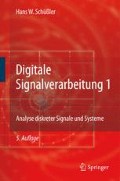Auszug
Praktisch realisierbare diskrete Systeme werden im allgemeinen durch Differenzengleichungen endlicher Ordnung beschrieben. Sie ergeben sich in einer noch zu erläuternden Weise als Spezialfälle der allgemeinen Systeme, deren Eigenschaften wir im letzten Kapitel untersucht haben.
Access this chapter
Tax calculation will be finalised at checkout
Purchases are for personal use only
Preview
Unable to display preview. Download preview PDF.
Literaturverzeichnis
Schüßler, H.W.: Netzwerke, Signale und Systeme. Bd. 2. Berlin: Springer 3. Auflage 1991
Unbehauen, R.: Systemtheorie. Grundlagen für Ingenieure. 5. Aufl. München: Oldenbourg 1990
Roberts, J.A.; Mullis, C.T.: Digital signal processing. Reading, Mass.: Addison-Wesley 1987
Graham, A.: Kronecker products and matrix calculus with applications. Ellis Horwood Series. New York: Halsted Press 1981
Kailath, Th.: Linear Systems. Englewood Cliffs, N.J.: Prentice-Hall 1980
Schüßler, H.W.: Netzwerke, Signale und Systeme, Bd. 1. Berlin: Springer 3. Auflage 1991
Power, H.M.: The mechanics of the bilinear transformation. IEEE Trans. Educ. 10 (1967) 114–116
Jury, E.I.; Chan, O.W.C.: Combinatorial rules for some useful transformations. IEEE Trans. Circuit Theory 20 (1973) 476–480
Davies, A.C.: Bilinear transformation of polynomials. IEEE Trans. Circuits and Systems 21 (1974) 792–794
Parthasarathy, R.; Jayasimha, K.N.: Bilinear transformation by synthetic division. IEEE Trans. Autom. Control 29 (1984) 575–576
Jury, E.I.: Theory and application of the z-transform method. Huntington, New York: Krieger 1973
Schüßler, H.W.: A stability theorem for discrete systems. IEEE Trans. Acoust. Speech Signal Process. 24 (1976) 87–89
Steffen, P.: An algorithm for testing stability of discrete systems. IEEE Trans. Acoust. Speech Signal Process. 25 (1977) 454–456
Aström, K.J.: Introduction to stochastic control theory. New York: Academic Press 1970
Tietz, H.: Funktionentheorie. Abschn. A in Sauer, R.; Szabó, I. (Hrsg.): Mathematische Hilfsmittel des Ingenieurs. Teil I. Berlin: Springer 1967
Boyd, St.: Multitone Signals with Low Crest Factor. IEEE Trans. Circuits and Systems, 33 (1986) 1018–1022
Vary, P.: Fast Digital Frequency Response Measurement with Multifrequency Signals, Arch. elektr. Übertrag. 34 (1980) 190–195
Unbehauen, R.: Determination of the transfer function of a digital filter from the real part of the frequency response. Arch. elektr. Übertrag. 26 (1972) 551–557
Schüßler, H.W.; Steffen, P.: On the Design of Allpasses with Prescribed Group Delay. Proc. of ICASSP Albuquerque (1990) 1313–1316
Zurmühl, R.; Falk, S.: Matrizen und ihre Anwendungen 1. Grundlagen. Berlin: Springer, 6. Auflage 1992
Burrus, C.S.; Parks, T.W.: DFT/FFT and Convolution Algorithms. New York: John Wiley & Sons 1985
Stoer J.: Einführung in die Numerische Mathematik I. Heidelberger Taschenbücher Band 105. Berlin: Springer 1972
Czarnach, R.: Recursive processing by noncausal digital filters. IEEE Trans. Acoust. Speech Signal Process. 30 (1982) 363–370
Jackson, L.B.: Digital Filters and Signal Processing, Third Eddition with MAT-LAB Exercises. Boston: Kluwer AcademicPublishers 1996
Oppenheim, A.V.; Schafer, R.W.: Discrete-Time Signal Processing. Upper Saddle River, N.J.: Prentice-Hall 1999
Dehner, G.F.: Noise optimized IIR Digital Filter Design-Tutorial and some new aspects. Signal Processing 83 (2003) 1565–1582
Mitra, S.K.; Kaiser, J.F.: Handbook for Digital Signal Processing. New York, NY: John Whily & Sons 1993
Levi, E.C.: Complex-Curve Fitting. IRE Trans. on Automatic Control AC-4 (1959) 37–44
Dennis, J.E.; Schnabel R.B.: Numerical methods for unconstrained optimization and nonlinear equations. Prentice-Hall, 1983
Bennet, W.R.: Distribution of the sum of randomly phased components. Quarterly Appl. Math. 5 (1948) 385–393
Schüßler, H.W.; Dong, Y.: A new method for measuring the performance of weakly nonlinear and noisy systems. Frequenz 44 (1990) 3–4
Schüßler, H.W.; Heinle, F.: Measuring the properties of implemented digital systems. Frequenz 48 (1994) 1–2
Burrus, C.S.; McClellan, J.H.; Oppenheim, A.V.; Parks, T.W.; Schafer, R.W.; Schüßler, H.W.: Computer-Based Exercises for Signal Processing using MAT-LAB. Upper Saddle River, N.J.: Prentice-Hall, 1994
Rights and permissions
Copyright information
© 2008 Springer-Verlag Berlin Heidelberg
About this chapter
Cite this chapter
(2008). Kausale, lineare Systeme, beschrieben durch Differenzengleichungen. In: Digitale Signalverarbeitung 1. Springer, Berlin, Heidelberg. https://doi.org/10.1007/978-3-540-78251-3_5
Download citation
DOI: https://doi.org/10.1007/978-3-540-78251-3_5
Publisher Name: Springer, Berlin, Heidelberg
Print ISBN: 978-3-540-78250-6
Online ISBN: 978-3-540-78251-3
eBook Packages: Computer Science and Engineering (German Language)

